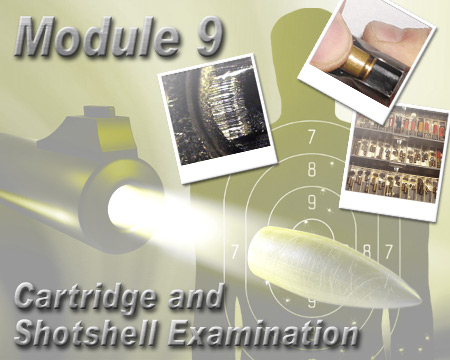Home | Glossary | Resources | Help | Contact Us | Course Map
Archival Notice
This is an archive page that is no longer being updated. It may contain outdated information and links may no longer function as originally intended.
| Author: John H. Dillon, Jr. |
| Jack Dillon earned a B. S. from the United States Naval Academy and an M. Ed. from the University of Virginia. Commissioned in the United States Marine Corps in 1964, he attained the rank of Captain of Marines. Appointed a Special Agent, FBI, in 1970, he investigated diverse criminal violations, including organized crime, bank robberies, extortions, and kidnappings. In 1976 he received orders to the Firearms/Toolmarks Unit of the FBI Laboratory for training as an examiner, where he evaluated evidence and provided on-site field support in domestic cases, as well as abroad. He also designed and taught basic- and management- level forensic courses at the FBI Academy, Quantico, Virginia, 1982-1988. Jack retired from the FBI as Chief of the Firearms/Toolmarks Unit in 1994, and continues to work as a consultant in forensic firearm cases and in training design and delivery. |
Introduction
This module addresses forensic firearm examinations relating primarily to the following categories of firearm-related evidence:
- Cartridge-related evidence:
- Fired cartridge cases (the portion of a fired cartridge left behind after a bullet has been fired, often referred to as brass in a nonforensic context)
- Unfired cartridges (unfired ammunition that is still complete, consisting of a projectile, propellant, primer, and a cartridge case assembled as a unit, often referred to as a round in a nonforensic context)
- Shotshell-related evidence:
- Fired shotshells (shotshell cases that no longer contain propellant, pellets, buckshot, wadding, buffer, or a shotgun slug)
- Unfired shotshells (intact shotshells that consist of the shotshell case, primer, powder, pellets, buckshot, wadding, buffer, or a shotgun slug assembled as a unit)
Objectives
At the conclusion of this module the student will be able to do the following:
- Describe the potential evidentiary value of reproducible striations and/or impressions produced during the normal functioning of a firearm
- Define the procedure for the microscopic comparison of the class and individual characteristics of firearms reflected on fired and unfired cartridge cases/shotshell cases
- List the equipment and facilities necessary to microscopically compare fired and unfired cartridge cases/shotshell cases
- Describe the marks that may be present on cartridges and shotshells as a result of being
- cycled through the action of a firearm,
- fired in a firearm.
- Articulate how the following concepts relate to the formulation of examination conclusions of fired and unfired cartridge cases and shotshell cases:
- Class characteristics
- Individual characteristics
- Subclass characteristics
- Pattern identification
- AFTE Theory of Identification
- Sufficient agreement
- Best known nonmatch
- Consecutive matching striae (CMS)
- Impressed marks
- AFTE Range of Conclusions
- Explain the differences between the following terms in regard to comparisons of fired and unfired cartridge cases and shotshell cases:
- Identification
- Inconclusive
- Elimination
- Unsuitable
- Define the contents of a typical fired cartridge case/unfired cartridge comparison worksheet for documentation of examination notes
- Describe the content and formats for reporting of results of comparisons of microscopic marks on fired and unfired cartridge cases/shotshell cases in terms of the AFTE Range of Conclusions
- Discuss in general terms the Integrated Ballistics Identification System (IBIS) in regard to preliminary remote comparisons (computer correlations) of cartridge cases/shotshell cases and case linkage in serial shooting cases
AFTE Knowledge and Ability Factors
| 17. | Knowledge of the proper methodologies for the written documentation of scientific results |
| 21. | Knowledge of testing procedures (protocol) commonly used to examine evidence, the expected results from each, and when to apply each |
| 26.* | Knowledge of definitions of class, subclass, and individual characteristics and the differences between them |
| 27.* | Knowledge of the sources of class, subclass, and individual characteristics |
| 42. | Knowledge of how and when to use pulled-bullet/cartridge exemplar files (SAF) |
| 115. | Knowledge of the toolmarks created during the reloading of ammunition |
| 116.* | Knowledge of the interactive nature of the tool/toolmark process and the transference of class, subclass, and individual characteristics |
| 117. | Knowledge of impressed (static) vs. striated (dynamic) toolmarks |
| 118. | Knowledge of the best agreement possible in situations of known non-matches when comparing toolmarks |
| 119. | Knowledge of the principles of preparing test marks and the effects of test materials in the production of test fired cartridge components and toolmarks for comparison |
| 21. | Ability to recognize discrepancies or inconsistencies in analytical findings and determine their cause and significance |
| 22. | Ability to recognize utility and limitations of reference collection/database programs |
| 23. | Ability to recognize the limitations of tests and interpretations |
| 31.* | Ability to recognize different manufacturing methods and, based upon this, to properly interpret potential for class, subclass, and individual characteristics |
| 34. | Ability to distinguish action markings from those caused during firing (action markings meaning mechanism marks) |
| 38. | Ability to recognize when fired bullets and cases have been fired in a firearm not designed for them |
| 39. | Ability to recognize, compare and identify various ammunition types and components |
| 40.* | Ability to recognize manufacturer-induced/placed toolmarks (subclass characteristics) on ammunition as well as their usefulness and limitations |
| 43. | Ability to recognize reloaded or handloaded ammunition |
| 44. | Ability to compare ammunition components on the basis of design characteristics or features |
| 46. | Ability to recognize: (1) those attributes or characteristics of a particular firearm design which are reflected in the fired projectiles and fired cartridge cases; and (2) nonfirearm caused toolmarks on ammunition components |
| 47. | Ability to determine the source and uniqueness of various striated and/or static marks on bullets and cartridges |
| 48. | Ability to recognize and properly align reproducible striae arrays sufficient for identification purposes |
| 49.* | Ability to recognize, determine the source of, and differentiate between class, subclass, and individual characteristics on bullets, cartridges, cartridge cases, and in nonfirearm related toolmarks |
| 50. | Ability to make comparisons between evidence and reference cartridges and recovered cartridge components |
| 53. | Ability to distinguish between the quality and quantity of matching striae in a true identity and that observed in known nonmatches |
| 54. | Ability to recognize commercially reloaded or handloaded ammunition components from their markings and characteristics |
| 56. | Ability to recognize the evidentiary value of reloaded ammunition |
| 57. | Ability to recognize any manufacturer-induced characteristics |
| 71. | Ability to make determinations in toolmark comparisons (both firearm and nonfirearm toolmarks) regarding identifications, exclusions, and inconclusives |
| 72. | Ability to recognize patterns (profiles, etc.) produced by various tool-working surfaces |
| 74. | Ability to recognize toolmarks as being class, subclass, or individual in nature |
| * | Module 9 includes information on class, subclass, and individual characteristics in regard to cartridge cases; Module 10 includes class characteristic information on fired and unfired bullets and Module 11 includes information on subclass and individual characteristics in regards to fired bullets |
Additional Online Courses
- What Every First Responding Officer Should Know About DNA Evidence
- Collecting DNA Evidence at Property Crime Scenes
- DNA – A Prosecutor’s Practice Notebook
- Crime Scene and DNA Basics
- Laboratory Safety Programs
- DNA Amplification
- Population Genetics and Statistics
- Non-STR DNA Markers: SNPs, Y-STRs, LCN and mtDNA
- Firearms Examiner Training
- Forensic DNA Education for Law Enforcement Decisionmakers
- What Every Investigator and Evidence Technician Should Know About DNA Evidence
- Principles of Forensic DNA for Officers of the Court
- Law 101: Legal Guide for the Forensic Expert
- Laboratory Orientation and Testing of Body Fluids and Tissues
- DNA Extraction and Quantitation
- STR Data Analysis and Interpretation
- Communication Skills, Report Writing, and Courtroom Testimony
- Español for Law Enforcement
- Amplified DNA Product Separation for Forensic Analysts



